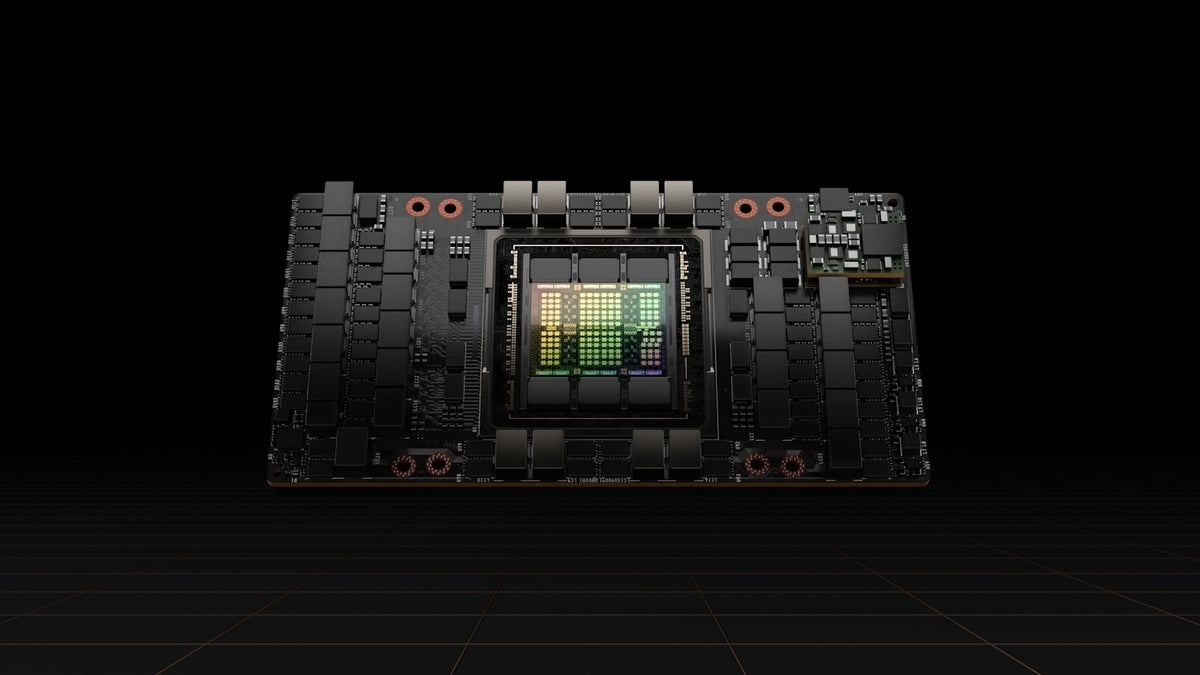Nvidia still crushing the data center market

EVGA CEO Andy Han cited several grievances with Nvidia, not the least of which
was that it competes with Nvidia. Nvidia makes graphics cards and sells them to
consumers under the brand name Founder’s Edition, something AMD and Intel do
very little or not at all. In addition, Nvidia’s line of graphics cards was
being sold for less than what licensees were selling their cards. So not only
was Nvidia competing with its licensees, but it was also undercutting them.
Nvidia does the same on the enterprise side, selling DGX server units
(rack-mounted servers packed with eight A100 GPUs) in competition with OEM
partners like HPE and Supermicro. Das defends this practice. “DGX for us has
always been sort of the AI innovation vehicle where we do a lot of item
testing,” he says, adding that building the DGX servers gives Nvidia the chance
to shake out the bugs in the system, knowledge it passes on to OEMs. “Our work
with DGX gives the OEMs a big head-start in getting their systems ready and out
there. So it's actually an enabler for them.” But both Snell and Sag think
Nvidia should not be competing against its partners. “I'm highly skeptical of
that strategy,” Snell says.
A Look Ahead: Cybersecurity Trends to Watch in 2023
Multifactor authentication was once considered the gold standard of identity
management, providing a crucial backstop for passwords. All that changed this
year with a series of highly successful attacks using MFA bypass and MFA fatigue
tactics, combined with tried-and-true phishing and social engineering. That
success won’t go unnoticed. Attackers will almost certainly increase multifactor
authentication exploits. "Headline news attracts the next wave of also-rans and
other bad actors that want to jump on the newest methods to exploit an attack,"
Bird says. "We're going to see a lot of situations where MFA strong
authentication is exploited and bypassed, but it's just unfortunately a reminder
to us all that tech is only a certain percentage of the solution." Ransomware
attacks have proliferated across public and private sectors, and tactics to
pressure victims into paying ransoms have expanded to double and even triple
extortion. Because of the reluctance of many victims to report the crime, no one
really knows whether things are getting better or worse.
Why zero knowledge matters

In a sense, zero knowledge proofs are a natural elaboration on trends in
complexity theory and cryptography. Much of modern cryptography (of the
asymmetric kind) is dependent on complexity theory because asymmetric security
relies on using functions that are feasible in one form but not in another. It
follows that the great barrier to understanding ZKP is the math. Fortunately, it
is possible to understand conceptually how zero knowledge proofs work without
necessarily knowing what a quadratic residue is. For those of us who do care, a
quadratic residue of y, for a value z is: . This rather esoteric concept was
used in one of the original zero knowledge papers. Much of cryptography is built
on exploring the fringes of math (especially factorization and modulus) for
useful properties. Encapsulating ZKP's complex mathematical computations in
libraries that are easy to use will be key to widespread adoption. We can do a
myriad of interesting things with such one-way functions. In particular, we can
establish shared secrets on open networks, a capability that modern secure
communications are built upon
Rust Microservices in Server-side WebAssembly
Rust enables developers to write correct and memory-safe programs that are as
fast and as small as C programs. It is ideally suited for infrastructure
software, including server-side applications, that require high reliability
and performance. However, for server-side applications, Rust also presents
some challenges. Rust programs are compiled into native machine code, which is
not portable and is unsafe in multi-tenancy cloud environments. We also lack
tools to manage and orchestrate native applications in the cloud. Hence,
server-side Rust applications commonly run inside VMs or Linux containers,
which bring significant memory and CPU overhead. This diminishes Rust’s
advantages in efficiency and makes it hard to deploy services in
resource-constrained environments, such as edge data centers and edge clouds.
The solution to this problem is WebAssembly (WASM). Started as a secure
runtime inside web browsers, Wasm programs can be securely isolated in their
own sandbox. With a new generation of Wasm runtimes, such as the Cloud Native
Computing Foundation’s WasmEdge Runtime, you can now run Wasm applications on
the server.
How to automate data migration testing

Testing with plenty of time before the official cutover deadline is usually
the bulk of the hard work involved in data migration. The testing might be
brief or extended, but it should be thoroughly conducted and confirmed before
the process is moved forward into the “live” phase. An automated data
migration approach is a key element here. You want this process to work
seamlessly while also operating in the background with minimal human
intervention. This is why I favor continuous or frequent replication to keep
things in sync. One common strategy is to run automated data synchronizations
in the background via a scheduler or cron job, which only syncs new data. Each
time the process runs, the amount of information transferred will become less
and less. ... Identify the automatic techniques and principles that will
ensure the data migration runs on its own. These should be applied across the
board, regardless of the data sources and/or criticality, for consistency and
simplicity’s sake. Monitoring and alerts that notify your team of data
migration progress are key elements to consider now.
Clean Code: Writing maintainable, readable and testable code
Clean code makes it easier for developers to understand, modify, and maintain
a software system. When code is clean, it is easier to find and fix bugs, and
it is less likely to break when changes are made. One of the key principles of
clean code is readability, which means that code should be easy to understand,
even for someone who is not familiar with the system. To achieve this,
developers should e.g. use meaningful names for variables, functions, and
classes. Another important principle of clean code is simplicity, which
means that code should be as simple as possible, without unnecessary
complexity. To achieve this, developers should avoid using complex data
structures or algorithms unless they are necessary, and should avoid adding
unnecessary features or functionality. In addition to readability and
simplicity, clean code should also be maintainable, which means that it should
be easy to modify and update the code without breaking it. To achieve this,
developers should write modular code that is organized into small, focused
functions, and should avoid duplication of code. Finally, clean code
should be well-documented.
Artificial intelligence predictions 2023

Synthetic data – data artificially generated by a computer simulation – will
grow exponentially in 2023, says Steve Harris, CEO of Mindtech. “Big companies
that have already adopted synthetic data will continue to expand and invest as
they know it is the future,” says Harris. Harris gives the example of car
crash testing in the automotive industry. It would be unfeasible to keep
rehearsing the same car crash again and again using crash test dummies. But
with synthetic data, you can do just that. The virtual world is not limited in
the same way, which has led to heavy adoptoin of synthetic data for AI road
safety testing. Harris says synthetic data is now being used in industries he
never expcted in order to improve development, services and innnovation. ...
Banks will use AI more heavily to give them a competitive advantage to analyse
the capital markets and spot opportunities. “2023 is going to be the year the
rubber meets the road for AI in capital markets, says Matthew Hodgson, founder
and CEO of Mosaic Smart Data. “Amidst the backdrop of volatility and economic
uncertainty across the globe, the most precious resource for a bank is its
transaction records – and within this is its guide to where opportunity
resides.
Group Coaching - Extending Growth Opportunity Beyond Individual Coaching
First, as a coach since our focus is on the relationship and interactions
between the individuals, we don’t coach individuals in separate sessions.
Instead, we bring them together as the group/team that they are part of and
coach the entire group. Anything said by one member of the team is heard by
everyone right there and then. The second building block is holding the mirror
to the intangible entity mentioned above. To be accurate, holding the mirror
is not a new skill for proponents of individual coaching, but it takes a
significantly different approach in group coaching and has a more pronounced
impact here. Holding the mirror here means picking up the intangibles and
making the implicit explicit, for example, sensing the mood in the room, or
reading the body language, drop/increase in energy, head nods, smiles, drop in
shoulders, emotions etc. and playing back to the room your observation (sans
judgement obviously). Making the intangibles explicit is an important step in
group coaching - name it to tame it, if you will. The third building block is
the believing and trusting in the group system that it is intelligent and
self-healing.
Hybrid cloud in 2023: 5 predictions from IT leaders

Hood says this trend is fundamentally about operators accelerating their 5G
network deployments while simultaneously delivering innovative edge services
to their enterprise customers, especially in key verticals like retail,
manufacturing, and energy. He also expects growing use of AL/ML at the edge to
help optimize telco networks and hybrid edge clouds. “Many operators have been
consuming services from multiple hyperscalers while building out their
on-premise deployment to support their different lines of business,” Hood
says. “The ability to securely distribute applications with access to data
acceleration and AI/ML GPU resources while meeting data sovereignty
regulations is opening up a new era in building application clouds independent
of the underlying network infrastructure.” ... “Given a background of low
margins, limited budgets, and the complexity of IT systems required to keep
their businesses operating, many retailers now understandably rely on a hybrid
cloud approach to help reduce costs whilst delivering value to their
customers,” says Ian Boyle, Red Hat chief architect for retail.
Looking ahead to the network technologies of 2023

The growth in Internet dependence is really what’s been driving the cloud,
because high-quality, interactive, user interfaces are critical, and the
cloud’s technology is far better for those things, not to mention easier to
employ than changing a data center application would be. A lot of cloud
interactivity, though, adds to latency and further validates the need for
improvement in Internet latency. Interactivity and latency sensitivity tend to
drive two cloud impacts that then become network impacts. The first is that as
you move interactive components to the cloud via the Internet, you’re creating
a new network in and to the cloud that’s paralleling traditional MPLS VPNs.
The second is that you’re encouraging cloud hosting to move closer to the edge
to reduce application latency. ... What about security? The Internet and cloud
combination changes that too. You can’t rely on fixed security devices inside
the cloud, so more and more applications will use cloud-hosted instances of
security tools. Today, only about 7% of security is handled that way, but that
will triple by the end of 2023 as SASE, SSE, and other cloud-hosted security
elements explode.
Quote for the day:
"Leadership is unlocking people's
potential to become better." -- Bill Bradley
No comments:
Post a Comment